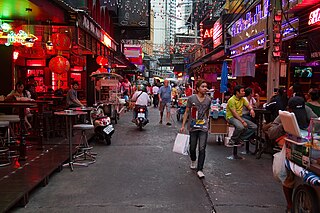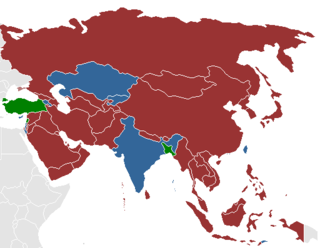Related Research Articles

Sex tourism refers to the practice of traveling to foreign countries, often on a different continent, with the intention of engaging in sexual activity or relationships in exchange for money or lifestyle support. This practice predominantly operates in countries where sex work is legal. The World Tourism Organization of the United Nations has acknowledged about this industry is organized both within and outside the structured laws and networks created by them.

Sexual slavery and sexual exploitation is an attachment of any ownership right over one or more people with the intent of coercing or otherwise forcing them to engage in sexual activities. This includes forced labor that results in sexual activity, forced marriage and sex trafficking, such as the sexual trafficking of children.

Trafficking of children is a form of human trafficking and is defined by the United Nations as the "recruitment, transportation, transfer, harboring, and/or receipt" kidnapping of a child for the purpose of slavery, forced labour, and exploitation. This definition is substantially wider than the same document's definition of "trafficking in persons". Children may also be trafficked for adoption.

Sex trafficking is human trafficking for the purpose of sexual exploitation. It has been called a form of modern slavery because of the way victims are forced into sexual acts non-consensually, in a form of sexual slavery. Perpetrators of the crime are called sex traffickers or pimps—people who manipulate victims to engage in various forms of commercial sex with paying customers. Sex traffickers use force, fraud, and coercion as they recruit, transport, and provide their victims as prostitutes. Sometimes victims are brought into a situation of dependency on their trafficker(s), financially or emotionally. Every aspect of sex trafficking is considered a crime, from acquisition to transportation and exploitation of victims. This includes any sexual exploitation of adults or minors, including child sex tourism (CST) and domestic minor sex trafficking (DMST).

Prostitution is legal in India, but a number of related activities including soliciting, kerb crawling, owning or managing a brothel, prostitution in a hotel, child prostitution, pimping and pandering are illegal. There are, however, many brothels illegally operating in Indian cities including Mumbai, Delhi, Kolkata, Bangalore, and Chennai. UNAIDS estimate there were 657,829 prostitutes in the country as of 2016. Other unofficial estimates have calculated India has roughly 3–10 million prostitutes. India is widely regarded as having one of the world's largest commercial sex industry. It has emerged as a global hub of sex tourism, attracting sex tourists from wealthy countries. The sex industry in India is a multi-billion dollar one, and one of the fastest growing.
Forced prostitution, also known as involuntary prostitution or compulsory prostitution, is prostitution or sexual slavery that takes place as a result of coercion by a third party. The terms "forced prostitution" or "enforced prostitution" appear in international and humanitarian conventions, such as the Rome Statute of the International Criminal Court, but have been inconsistently applied. "Forced prostitution" refers to conditions of control over a person who is coerced by another to engage in sexual activity.

The continent of Africa is one of the regions most rife with contemporary slavery. Slavery in Africa has a long history, within Africa since before historical records, but intensifying with the trans-Saharan and Indian Ocean slave trade and again with the trans-Atlantic slave trade; the demand for slaves created an entire series of kingdoms which existed in a state of perpetual warfare in order to generate the prisoners of war necessary for the lucrative export of slaves. These patterns persisted into the colonial period during the late 19th and early 20th century. Although the colonial authorities attempted to suppress slavery from about 1900, this had very limited success, and after decolonization, slavery continues in many parts of Africa despite being technically illegal.

Contemporary slavery, also sometimes known as modern slavery or neo-slavery, refers to institutional slavery that continues to occur in present-day society. Estimates of the number of enslaved people today range from around 38 million to 49.6 million, depending on the method used to form the estimate and the definition of slavery being used. The estimated number of enslaved people is debated, as there is no universally agreed definition of modern slavery; those in slavery are often difficult to identify, and adequate statistics are often not available.
According to the United States Department of State, "Thailand is a source, destination, and transit country for men, women, and children subjected to forced labour and sex trafficking." Thailand's relative prosperity attracts migrants from neighboring countries who flee conditions of poverty and, in the case of Burma, military repression. Significant illegal migration to Thailand presents traffickers with opportunities to coerce or defraud undocumented migrants into involuntary servitude or sexual exploitation. Police who investigated reaching high-profile authorities also received death threats in 2015.

Human trafficking is the trade of humans for the purpose of forced labour, sexual slavery, or commercial sexual exploitation. Human trafficking can occur within a country or trans-nationally. It is distinct from people smuggling, which is characterized by the consent of the person being smuggled.

The sex industry consists of businesses that either directly or indirectly provide sex-related products and services or adult entertainment. The industry includes activities involving direct provision of sex-related services, such as prostitution, strip clubs, host and hostess clubs and sex-related pastimes, such as pornography, sex-oriented men's magazines, women's magazines, sex movies, sex toys and fetish or BDSM paraphernalia. Sex channels for television and pre-paid sex movies for video on demand, are part of the sex industry, as are adult movie theaters, sex shops, peep shows, and strip clubs. The sex industry employs millions of people worldwide, mainly women. These range from the sex worker, also called adult service provider (ASP), who provides sexual services, to a multitude of support personnel.
Human trafficking is the trade of humans, most commonly for the purpose of forced labour, sexual slavery, or commercial sexual exploitation for the trafficker or others. Mexico is a large source, transit, and destination country for victims of human trafficking.

Sex trafficking is defined as the transportation of persons by means of coercion, deception and/or forced into exploitative and slavery-like conditions and is commonly associated with organized crime.

The trafficking of persons is the fastest growing and most profitable criminal activity after drug and arms trafficking. According to the United Nations Protocol to Prevent, Suppress and Punish Trafficking in Persons, Especially Women and Children, human trafficking is defined as follows: “Trafficking in persons shall mean the recruitment, transportation, transfer, harboring or receipt of persons, by means of the threat or use of force or other forms of coercion, of abduction, of fraud, of deception, of the abuse of power or of a position of vulnerability or of the giving or receiving of payments or benefits to achieve the consent of a person having control over another person, for the purpose of exploitation. Exploitation shall include, at a minimum, the exploitation of the prostitution of others or other forms of sexual exploitation, forced labor or services, slavery or practices similar to slavery, servitude or the removal of organs.”

Prostitution is legal in Macau unlike in mainland China, because the city is a special administrative region of the country. However, operating a brothel and procuring are both illegal in Macau, with the latter punishable by a maximum jail sentence of 8 years. Street prostitution is illegal but sex work in a massage parlor is considered to be de facto legal. The city has a large sex trade despite there being no official red-light district. In addition to street prostitution, prostitutes work in low-rent buildings, massage parlours and illegal brothels, and the casinos, nightclubs, saunas and some of the larger hotels. Most hotels, however, have suspected prostitutes removed from the premises. Many of the city's sidewalks and underpasses are littered with prostitutes' calling cards.

Although slavery is recognized as being illegal around the world by international treaties and conventions, evidence has shown that there is still existing slavery in Yemen, and the number of slaves is in fact growing. Slavery affects and inhibits many basic human rights, and was specifically abolished by Yemen in 1962. That slavery is alleged to still exist is a major human rights issue.

Sex trafficking in the United States is a form of human trafficking which involves reproductive slavery or commercial sexual exploitation as it occurs in the United States. Sex trafficking includes the transportation of persons by means of coercion, deception and/or force into exploitative and slavery-like conditions. It is commonly associated with organized crime.
Sex trafficking in China is human trafficking for the purpose of sexual exploitation and slavery that occurs in the People's Republic of China. China, the world's second-most populous country, has the second highest number of human trafficking victims in the world. It is a country of origin, destination, and transit for sexually trafficked persons.
Trafficking of Korean women in the United States has been practiced for over a few decades and is known to be a transnational social problem. These women have either been kidnapped, groomed, recruited and usually transported to domestic and or foreign land by use of; threats, coercion, fraud or physical and verbal abuse. Korean women have been sexually exploited, forced to commit strenuous labor, and or transport illegal product, such as drugs, that are smuggled by use of their bodies in some cases. Trafficking of Korean women has been practiced since the late 1930s in Asia. Victims can range from pre-teen years of age to their thirties or later. Korean women are often stigmatized in the United States, as being women who are here in the states as sex workers. Over time, U.S. contributions toward combatting human trafficking amongst Korean women have been issued. Law enforcement agencies and several departments of U.S. government have provided these women a way out of the trafficking culture, whether they identify as voluntary or involuntary sex workers. As Korean women, their identity plays a unique role in how different forms of systematic oppression affects them.
References
- ↑ Hackett, Jon (6 December 2022), "Trafficking on film: a critical survey", Modern Slavery and Human Trafficking, Policy Press, pp. 95–112, ISBN 978-1-4473-6366-8 , retrieved 16 August 2023
- ↑ Plambech, Sine (30 September 2016). "The Art of the Possible: Making films on sex work migration and human trafficking". Anti-Trafficking Review (7): 182–199. doi: 10.14197/atr.201217710 . ISSN 2287-0113.
- ↑ Yea, Sallie (2020), Yea, Sallie (ed.), "Girls on Film: Framing Human Trafficking Through Film and the Cinema", Paved with Good Intentions? Human Trafficking and the Anti-trafficking Movement in Singapore, Singapore: Springer, pp. 59–86, doi:10.1007/978-981-13-3239-5_3, ISBN 978-981-13-3239-5, S2CID 213367293 , retrieved 16 August 2023
- ↑ Austin, Rachel; Farrell, Amy (26 April 2017), "Human Trafficking and the Media in the United States", Oxford Research Encyclopedia of Criminology and Criminal Justice, doi:10.1093/acrefore/9780190264079.013.290, ISBN 978-0-19-026407-9 , retrieved 16 August 2023
- ↑ Bickford, Donna M. (2 January 2018). "Hell Gate: The Implications of Representations of Human Trafficking in Popular Culture". Journal of Human Trafficking. 4 (1): 96–99. doi:10.1080/23322705.2018.1423453. ISSN 2332-2705. S2CID 158797115.
- ↑ Kinney, Edith (2015), Guia, Maria João (ed.), "Victims, Villains, and Valiant Rescuers: Unpacking Sociolegal Constructions of Human Trafficking and Crimmigration in Popular Culture", The Illegal Business of Human Trafficking, Cham: Springer International Publishing, pp. 87–108, doi:10.1007/978-3-319-09441-0_7, ISBN 978-3-319-09441-0 , retrieved 16 August 2023
- ↑ Berlatsky, Noah (10 June 2014). "Hollywood's dangerous obsession with sex trafficking". Salon. Retrieved 16 August 2023.